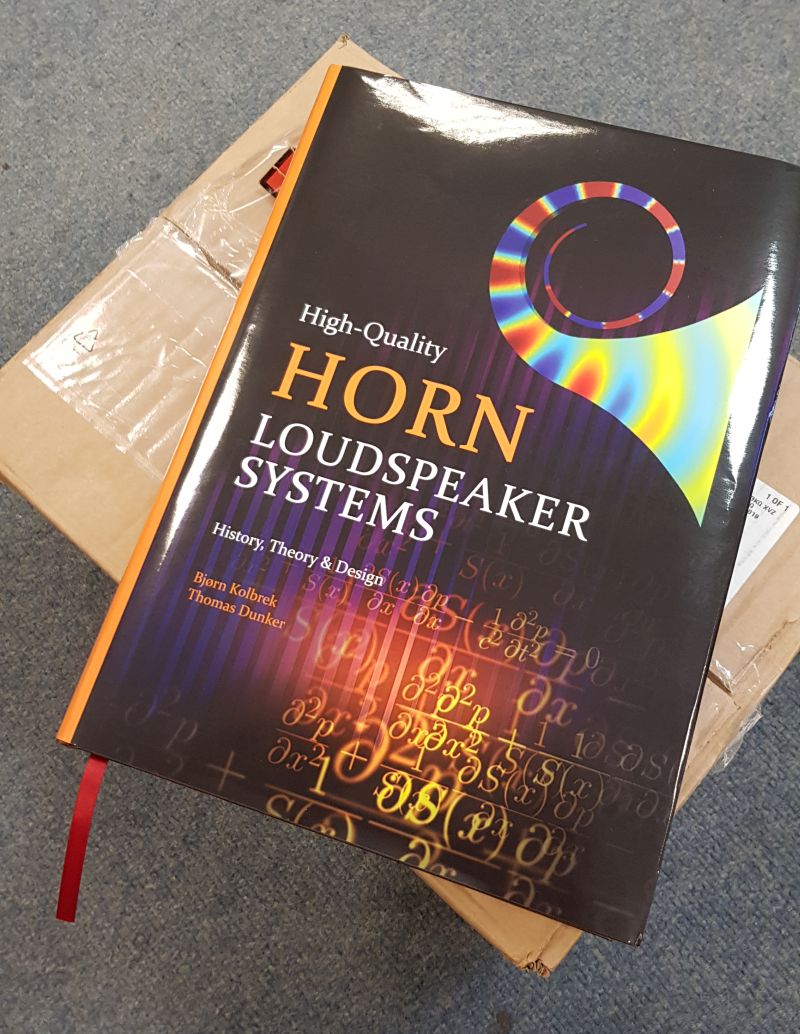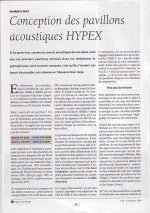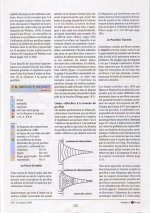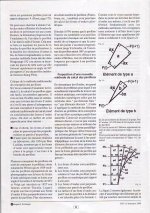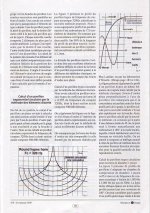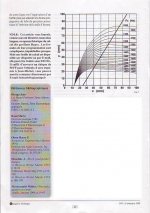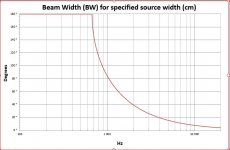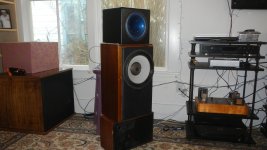Is it possible to cover the whole spectrum, high spl, low distortion with a 2-way?Around the same time, Bjørn Kolbrek posted some BEM sims of the AH425 (Azura Horn) in Lynn Olson's "Beyond the Ariel" thread.
The AH425 is a smaller JMLC horn.
The AH-340 with full roll back is probably more akin to camplo's horns.
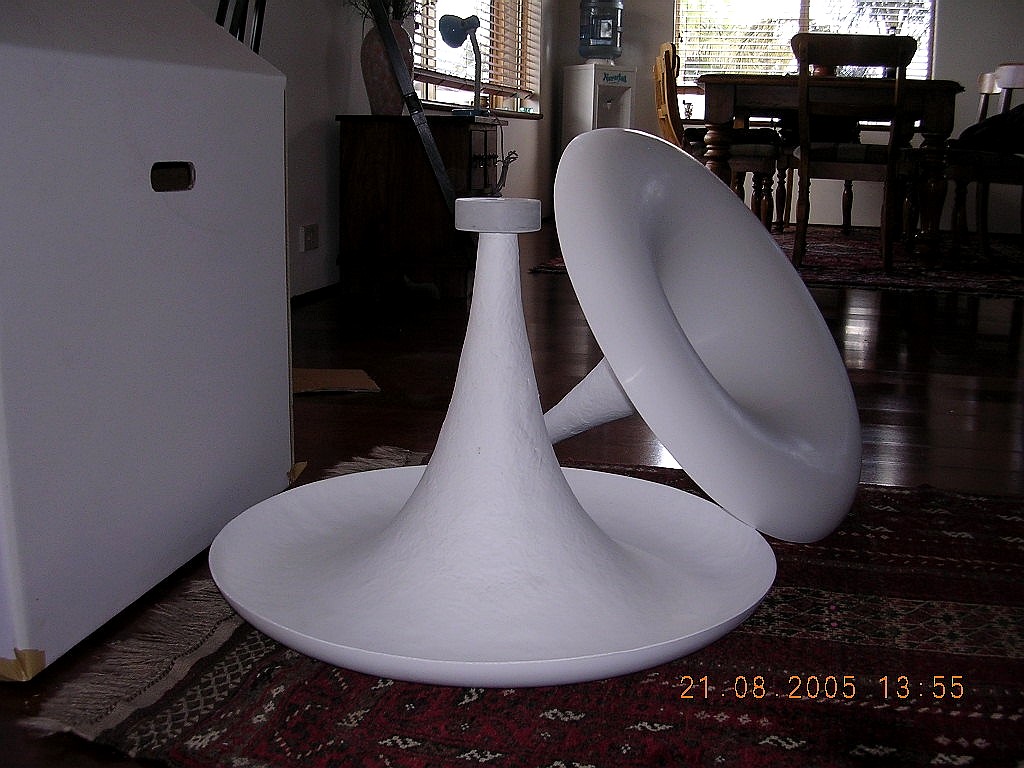
First time I seen something like this Ro808, outside of the Autotech page, Thank you so much for posting this. Look at the off axis response....its soooo beautiful

Last edited:
The first comment on the Axi2050 vs 951BePB is by Björn Omholt, I suppose?
If you want to cross <500Hz and play at high SPL, the Axi2050 would definitely beat the 951BePB.
I am sure at 300Hz and >115dB, the Beryllium diaphragm won't last long.
Björn Kolbrek stated, he wouldn't hesitate to use the Axi2050 at, or even below 200Hz behind a proper horn at home.
The Axi2050 is (only) about $500 each, if you could order these through an OEM.
Some Romanian guys use the Axi2050 with these EV HP9040 horns:
where....where did he state this? Not to mention, look at the frequency response....how are you going to iron that out down to 200hz. Maybe this is where the "right horn" comes in. Maybe in a 100hz jmlc the response is naturally extended.
Last edited:
Do you refer to BEM sims by Bjørn Kolbrek?
Those were partly obtained without driver.
Quote from Bjørn Kolbrek's homepage:
"New interesting compression driver
Celestion recently came out with a new compression driver, the Axi2050. For people like me who are interested in large midrange horns covering most of the vocal range (and I'm not talking about the 300Hz-3kHz telephone range, but more like 100Hz to 5kHz), this driver is very interesting. Especially since the high end response is very good for such a large unit. It's more of a mid-high than a midrange driver. Take a look at the frequency response curves, taken from the Celestion data sheet:

The PWT response is only shown down to 100Hz, but it is basically flat down to that frequency. In addition, the HF response looks good up to about 10kHz. That's two decades! And the HF sounds pretty good too; I got a change to hear one such driver on a straight circular Hypex horn at the Celestion factory, and it actually had a nice, smooth high end. Moreover, the driver is rated for 150W down to 300Hz, and the diaphragm is large, so for domestic use, using it down to 100Hz or even lower would not be a problem."
Those were partly obtained without driver.
where....where did he state this? Not to mention, look at the frequency response....how are you going to iron that out down to 200hz. Maybe this is where the "right horn" comes in. Maybe in a 100hz jmlc the response is naturally extended.
Quote from Bjørn Kolbrek's homepage:
"New interesting compression driver
Celestion recently came out with a new compression driver, the Axi2050. For people like me who are interested in large midrange horns covering most of the vocal range (and I'm not talking about the 300Hz-3kHz telephone range, but more like 100Hz to 5kHz), this driver is very interesting. Especially since the high end response is very good for such a large unit. It's more of a mid-high than a midrange driver. Take a look at the frequency response curves, taken from the Celestion data sheet:

The PWT response is only shown down to 100Hz, but it is basically flat down to that frequency. In addition, the HF response looks good up to about 10kHz. That's two decades! And the HF sounds pretty good too; I got a change to hear one such driver on a straight circular Hypex horn at the Celestion factory, and it actually had a nice, smooth high end. Moreover, the driver is rated for 150W down to 300Hz, and the diaphragm is large, so for domestic use, using it down to 100Hz or even lower would not be a problem."
For those interested and able to read some French, here's the original article in which JMLC describes his horns.
The method for calculating the "Le Cléac'h" horns was presented in issue 6 of the "Musique et Technique" magazine (2nd quarter 1999) in an article entitled "Design of HYPEX Acoustic horns".
The origin of this method lies in the fact that it makes no assumptions about the shape of the wavefront.
The article by Jean-Michel Le Cléac'h exposes only the principle of the method without detailing the calculations but this description is sufficient to find the equations that allow to calculate the profile. Details of these equations can be found in Pavilion JMLC.pdf .
Several companies offer Le Cléac'h horns. The image below shows the JMLC-350 manufactured by the Polish company Auto-Tech. As can be seen the roll back of the profile is close to 360 degrees which allows to take full advantage of the quality of this type of horn.
The method for calculating the "Le Cléac'h" horns was presented in issue 6 of the "Musique et Technique" magazine (2nd quarter 1999) in an article entitled "Design of HYPEX Acoustic horns".
The origin of this method lies in the fact that it makes no assumptions about the shape of the wavefront.
The article by Jean-Michel Le Cléac'h exposes only the principle of the method without detailing the calculations but this description is sufficient to find the equations that allow to calculate the profile. Details of these equations can be found in Pavilion JMLC.pdf .
Several companies offer Le Cléac'h horns. The image below shows the JMLC-350 manufactured by the Polish company Auto-Tech. As can be seen the roll back of the profile is close to 360 degrees which allows to take full advantage of the quality of this type of horn.
An externally hosted image should be here but it was not working when we last tested it.
Attachments
If the Axi2050 is close to the Holy Grail then why don't we talk to Celestion for a GB? Or talk to an OEM?
I am OK to use the second best driver on the planet
Possibly, if a substantial order could be placed.
What would be the best driver on the planet ?
Not the 950BePB, I assume?
There was huge irony in that post  It has never been about the "best" driver, more about the "best" implementation. Sorry for the poor quality but that commercial illustrates it quite well:
It has never been about the "best" driver, more about the "best" implementation. Sorry for the poor quality but that commercial illustrates it quite well:
YouTube
Boris Becker:"Tomorrow - tennis!"
In a recent review Ed Meitner talked about engineering "hygiene" - when all other things, actually immeasurably many variables are well taken care of we can discuss subjectively what we prefer, tailor it to our own taste.
And that is why I like this thread, you and others provided so much wisdom and so many stupid myths have been shredded that for someone who really wants to do it right this will save years of futile efforts.
YouTube
Boris Becker:"Tomorrow - tennis!"
In a recent review Ed Meitner talked about engineering "hygiene" - when all other things, actually immeasurably many variables are well taken care of we can discuss subjectively what we prefer, tailor it to our own taste.
And that is why I like this thread, you and others provided so much wisdom and so many stupid myths have been shredded that for someone who really wants to do it right this will save years of futile efforts.
...Not to mention, look at the frequency response....how are you going to iron that out down to 200hz. Maybe this is where the "right horn" comes in. Maybe in a 100hz jmlc the response is naturally extended.
If.......If it can play from 200hz to 20,000, thats wonderful....
I am no guru when it comes to "pairing" various drivers, choice of filters etc but as TD 18H+ has been mentioned, I measured its actual cone diameter on the ones I have. Cone Ø is 360 mm excluding the surround, with surround 405 mm.
If one goes on theory, beaming and beamwidth from that cone diameter and want to pair it with a horn with horisontal dispersion X degrees, it should be about:
Beamwidth 70 deg <=> about 1170 Hz
Beamwidth 80 deg <=> about 1044 Hz
Beamwidth 90 deg <=> about 950 Hz
Beamwidth 100 deg <=>about 875 Hz
Beamwidth 110 deg <=>about 819 Hz
Beamwidth 120 deg <=>about 775 Hz
From memory and some old measurements the TD 18 H+ fell off very sharply at around 1200 Hz but seemed to be quite decent below that. (I don't know really if I have those measurements saved or if they are on a dead hard disc.)
If one goes on theory, beaming and beamwidth from that cone diameter and want to pair it with a horn with horisontal dispersion X degrees, it should be about:
Beamwidth 70 deg <=> about 1170 Hz
Beamwidth 80 deg <=> about 1044 Hz
Beamwidth 90 deg <=> about 950 Hz
Beamwidth 100 deg <=>about 875 Hz
Beamwidth 110 deg <=>about 819 Hz
Beamwidth 120 deg <=>about 775 Hz
From memory and some old measurements the TD 18 H+ fell off very sharply at around 1200 Hz but seemed to be quite decent below that. (I don't know really if I have those measurements saved or if they are on a dead hard disc.)
Attachments
I don't understand what's so wonderful about the Axi2950. It doesn't play remarkably high or low. It does look well behaved on axis, but that's all I've seen so far. Can someone explain? Would it really be suitable for a 2-way speakers?
I think the attraction is in both how low it goes and how well behaved it is in the top half octave compared to other large format compression drivers. Its not perfectly smooth there but its not exhibiting the breakup that plagues all but BE drivers that can't go anywhere near as low.
For home use, the ability to cross at 200 Hz, or perhaps even lowers, is huge. The XO determines how large the horn can be before it pushes the external woofers so far apart you have lobing issues.
That is not to say that one might not do even better and save $ with a Synergy approach using a 1" CD or that good system solutions based on prior art don't exist.
For home use, the ability to cross at 200 Hz, or perhaps even lowers, is huge.
Why is that? There is virtually no CD horn that can match the directivity of the woofer at those frequencies. Is lack of lobbing worth giving up CD? I think not.
As you would usually be the first to say, its in the system design whether one gives up CD. I for one don't want a horn large enough to provide directivity at 200 Hz in my home. I would expect that in any solution I developed both horn and woofer would be omni at that frequency or that I was employing multiple drivers and beam forming techniques to maintain directivity down there. Or cheat like I did in the thread in my signature and make a corner horn where the corner walls provide the directivity.
It depends on one's desires and objectives, I guess.
For a single seat system, CD may not be on top of the priority list.
Personally, I like even coverage across the room, so that everyone present can enjoy the music to the same extent.
Regarding a CD horn for large drivers such as the Axi2050, DCX464 and HF1440 I have some ideas for a DIY solution.
For a single seat system, CD may not be on top of the priority list.
Personally, I like even coverage across the room, so that everyone present can enjoy the music to the same extent.
Regarding a CD horn for large drivers such as the Axi2050, DCX464 and HF1440 I have some ideas for a DIY solution.
....
Regarding a CD horn for large drivers such as the Axi2050, DCX464 and HF1440 I have some ideas for a DIY solution.
Most interesting
It depends on one's desires and objectives, I guess.
For a single seat system, CD may not be on top of the priority list.
Seems to me that the professional audio community is virtually united in its belief that CD is a strong requirement. And this is based on a lot of research (i.e. Toole, etc.) Ignore these facts at your own peril.
Seems to me that the professional audio community is virtually united in its belief that CD is a strong requirement. And this is based on a lot of research (i.e. Toole, etc.) Ignore these facts at your own peril.
Agreed. Even if it is one seat, and using a non CD waveguide, you move your head just a few inches and the response at the top is not the same. i.e. the beamwidth is about the size of a pencil light beam at 10 kHz. So hi hat and cymbals in one head position sound too much and then move the head a few inches and the hi hat and cymbals all but disappear.
And if you are a believer in Toole's and Olive's work and the now spinorama standard that can be downloaded for free, the off-axis response and reflections contribute to the direct sound and one may never get the on-axis response flat/even to begin with.
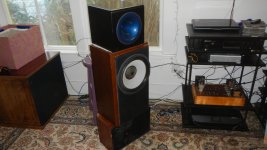
Prototype #1 of a speaker inspired by this thread. Top box is an Edgarhorn 650hz "salad bowl" tractrix horn with an Altec Lansing 902 CD in a Parts Express cube. Bottom box is an old repurposed speaker box with an Altec/GPA 414-8c woofer. The box is about 1.1 cubic feet net. The crossover is a Marchand active 24db/oct set at 1200 hz. I also use a passive speaker level circuit to raise the highest frequencies. Obviously, the crossover is not optimized.
And the horn will likely be replaced. With what, I don't know yet. So far, it sounds excellent. I sit only about 10 feet from the speakers, but there is no hint of separate sources, and the imaging is outstanding. As expected, the balance changes when I stand up or move forward. Subwoofer in the corner is a Dayton 15" (don't remember which) and a plate amp in a box made out of solid Padauk by a friend. Any suggestions for a passive crossover and different horn for this combination would be appreciated.
Attachments
- Home
- Loudspeakers
- Multi-Way
- Is it possible to cover the whole spectrum, high SPL, low distortion with a 2-way?
